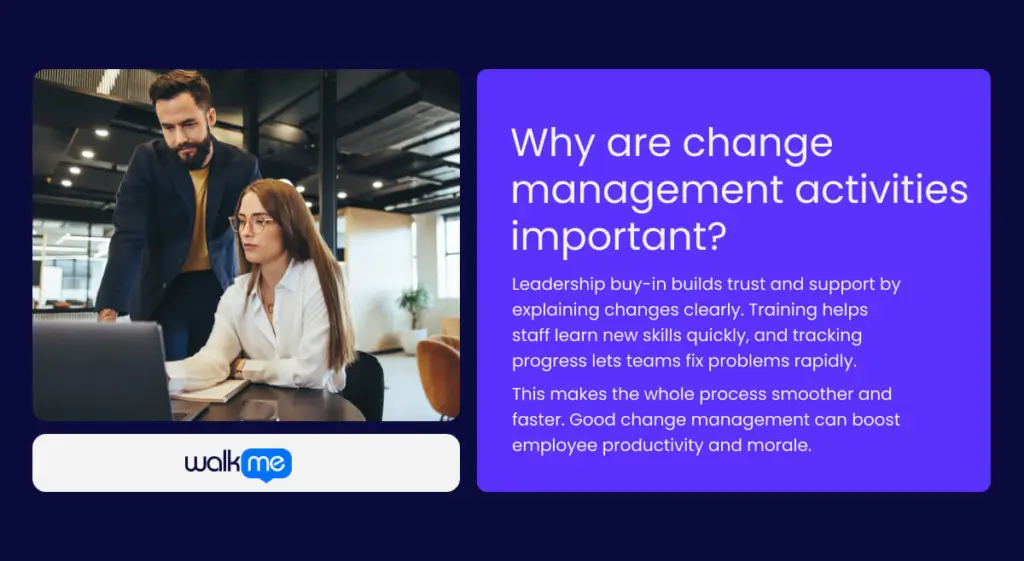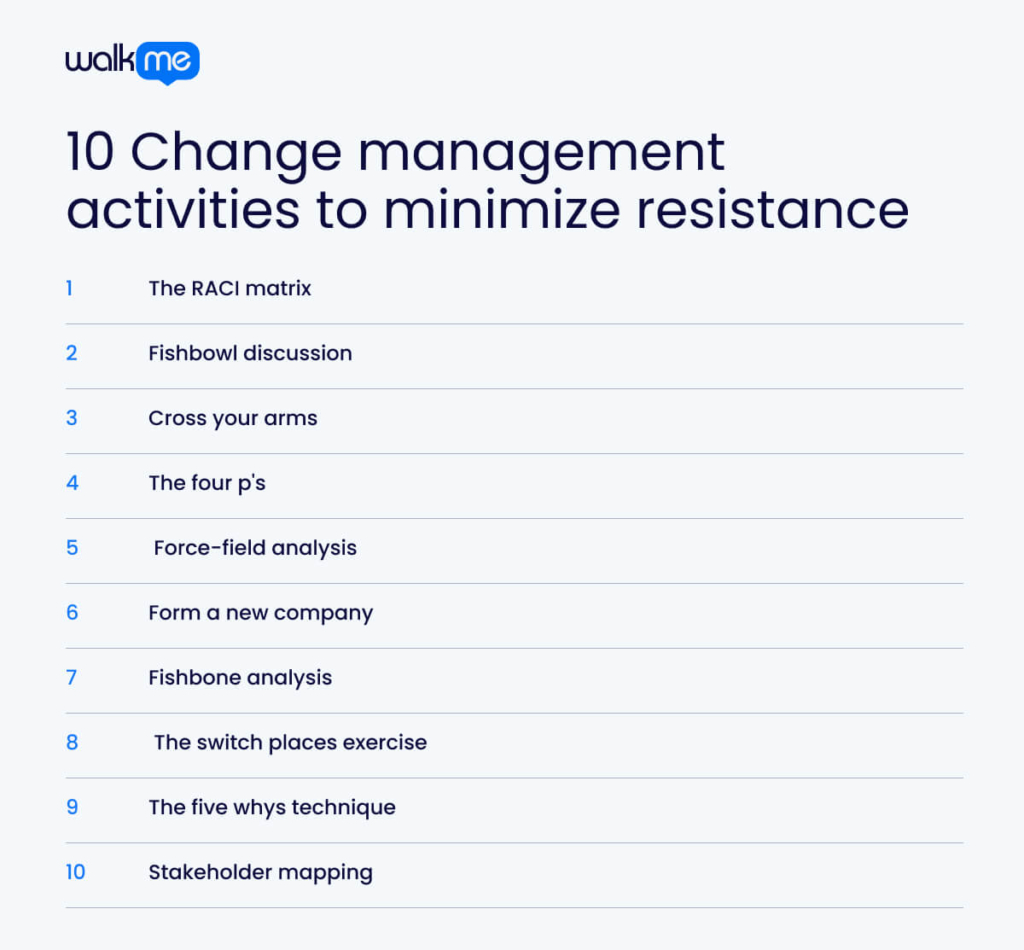Change is constant.
Organizations face shifting markets, new technologies, and evolving customer needs.
Success often hinges on how well a company adapts. This is where change management activities come into play. These crucial processes help businesses navigate transitions smoothly.
They address the human side of change, ensuring employees are ready, willing, and able to embrace new ways of working.
From small tweaks to major overhauls, change management activities pave the way for growth and innovation.
Change management activities help make your change initiative more fun, interesting, and productive.
This article will explore ten change management activities to try in 2024 to reduce resistance to change in your organization.
What are change management activities?
Change activities are structured approaches to guide organizations through transition management.
Change management activities help organizations handle big shifts smoothly. These steps guide everyone through new ways of working, starting with planning and ending with making sure changes stick.
Leaders explain why changes are needed and listen to worries. Teams get training and help to adjust. The work tracks how things are going and solves issues. These steps make changes easier for workers and better for the company.
By working through these steps, companies can turn tough changes into opportunities to grow and improve. The goal is to help everyone progress, turning new ideas into lasting improvements.
Why are change management activities important?

Change management activities are vital for business success. They help companies adapt to new markets, technology, and customer needs.
Without them, changes often fail, wasting time and money. These activities prepare workers for new ways of doing things and reduce stress and confusion during big shifts.
Leadership buy-in builds trust and support by explaining changes clearly. Training helps staff learn new skills quickly, and tracking progress lets teams fix problems rapidly.
This makes the whole process smoother and faster. Good change management can boost employee productivity and morale.
Change management activities help companies stay ahead of rivals and grab new chances. In short, they turn risky changes into opportunities for growth and success.
10 Change management activities to minimize resistance

Change management offers a diverse toolkit of strategies to help organizations navigate transitions effectively.
These techniques range from analytical approaches to interactive exercises designed to address different aspects of the change process.
Here are ten noteworthy change management activities:
1. The RACI matrix
The RACI Matrix is a powerful tool for clarifying roles and responsibilities during organizational change. It helps teams understand who is responsible, accountable, Consultable, and informed for various tasks and decisions. This clarity reduces confusion, prevents duplication of efforts, and ensures that all aspects of a change plan are properly managed.
Goal: To create clear accountability and improve communication within project teams.
Implementation:
- List all tasks or deliverables for the change project.
- Identify all roles involved in the project.
- Assign R, A, C, or I for each task to the relevant roles.
- Review the matrix with the team to ensure agreement and understanding.
- Use the matrix to guide project execution and communication.
2. Fishbowl discussion
The Fishbowl Discussion is a dynamic group dialogue technique that fosters open communication and diverse perspectives during change initiatives. It involves a small group discussing a topic while others observe, with the opportunity for observers to join the conversation. This method encourages active listening, promotes empathy, and helps surface various viewpoints on complex change-related issues.
Goal: To facilitate inclusive dialogue and gather diverse insights on change-related topics.
Implementation:
- Arrange chairs in two circles – an inner circle for active discussants and an outer circle for observers.
- Select initial participants for the inner circle and define the topic.
- Begin the discussion among inner circle members.
- Allow observers to join the inner circle by tapping out a current participant.
- Continue the process, encouraging the rotation of participants.
- Conclude with a debrief to summarize key points and learnings.
3. Cross your arms
The Cross Your Arms exercise is a simple yet effective demonstration of how ingrained habits can affect our responses to change. This activity provides a tangible experience of the discomfort and resistance often accompanying organizational changes, even when they seem minor. Making participants aware of their own reactions to a small physical change opens discussions about larger-scale changes in the workplace.
Goal: To illustrate the challenges of changing habitual behaviors and increase empathy for those experiencing organizational change.
Implementation:
- Ask participants to cross their arms in their usual way.
- Instruct them to notice which arm is on top and how comfortable it feels.
- Now, ask them to uncross their arms and recross them with the opposite arm on top.
- Encourage participants to reflect on how this feels different or uncomfortable.
- Facilitate a discussion about the experience, relating it to workplace changes.
- Draw parallels between this simple exercise and more complex organizational changes.
4. The four p’s
The Four P’s is a structured approach to planning and communicating change initiatives. This framework helps change leaders consider and articulate the key aspects of a change project: Purpose, Picture, Plan, and Part. By addressing these four elements, organizations can create a more comprehensive and compelling case, increasing buy-in and reducing resistance to change.
Goal: To develop a clear and persuasive message addressing stakeholders’ fundamental questions about the change.
Implementation:
- Define the Purpose: Clearly explain why the change is necessary.
- Paint the Picture: Describe what the future will look like after the change.
- Outline the Plan: Detail the steps that will be taken to implement the change.
- Clarify each person’s Part: Specify how individuals will be involved and affected.
- Use this framework to create communication materials and presentations.
- Review and refine the Four P’s regularly throughout the change process.
5. Force-field analysis
Force-field analysis is a decision-making technique for identifying and evaluating the forces supporting and opposing a proposed change. This method helps change managers visualize the balance between driving forces (factors encouraging the change) and restraining forces (factors resisting the change). By understanding these forces, organizations can develop strategies to strengthen and mitigate positive influences.
Goal: To assess the viability of a change initiative and identify areas where intervention can increase the likelihood of success.
Implementation:
- Clearly define the proposed change at the top of the page.
- Draw a line down the center of the page.
- List all driving forces on the left side and all restraining forces on the right.
- Assign a score to each force based on its impact (e.g., 1-5).
- Analyze the diagram to determine if the change is viable.
- Develop strategies to increase driving forces and reduce restraining forces.
- Create an action plan based on the analysis.
6. Form a new company
The Form a New Company exercise is an imaginative activity that encourages participants to think creatively about organizational structure and processes. Asking teams to design a hypothetical company from scratch helps break free from existing paradigms and generates fresh ideas for change. It’s particularly useful for identifying inefficiencies in current practices and envisioning innovative solutions.
Goal: To stimulate creative thinking about organizational design and identify potential improvements in current processes.
Implementation:
- Divide participants into small groups.
- Provide a scenario for a new company in the same industry.
- Ask groups to design the ideal structure, processes, and culture for this new company.
- Encourage them to consider how they would operate without current constraints.
- Have each group present their “new company” design.
- Facilitate a discussion comparing these designs to the current organization.
- Identify potential changes that could be implemented in the real organization.
7. Fishbone analysis
Fishbone Analysis, also known as the Ishikawa Diagram or Cause-and-Effect Diagram, is a visual tool used to identify and organize potential causes of a problem or effect. In change management, it helps teams systematically explore and display the various factors that may contribute to resistance or challenges in implementing organizational change. This technique encourages comprehensive problem-solving and helps prioritize areas for intervention.
Goal: To identify and categorize the root causes of problems or resistance in a change initiative.
Implementation:
- Draw a horizontal arrow pointing to the main problem or effect on the right side of a page.
- Draw diagonal lines branching off this arrow, representing the main categories of potential causes (e.g., People, Process, Technology, Environment).
- Brainstorm specific causes within each category and add them as smaller “bones” of the main branches.
- Analyze the completed diagram to identify the most significant factors.
- Prioritize the causes based on their impact and the organization’s ability to address them.
- Develop action plans to address the key causes identified.
8. The switch places exercise
The Switch Places Exercise is an empathy-building activity that helps participants understand different perspectives within an organization during change. By temporarily assuming the roles of others, team members gain insights into the challenges and concerns faced by colleagues at various levels or in different departments. This exercise fosters better communication and collaboration across the organization during change initiatives.
Goal: To increase empathy and understanding among team members by experiencing change from different organizational perspectives.
Implementation:
- Identify key roles or departments within the organization affected by the change.
- Assign participants to “switch places” with someone in a different role or department.
- Provide a brief scenario related to the change initiative.
- Ask participants to respond to the scenario from their assigned perspective.
- Encourage them to consider their new role’s concerns, priorities, and challenges.
- Facilitate a group discussion where participants share their experiences and insights.
- Guide the group in identifying ways to address diverse needs and concerns in the change process.
9. The five whys technique
The Five Whys Technique is a simple yet powerful problem-solving method used to uncover the root cause of a problem or resistance to change. By repeatedly asking “Why?” (typically five times), this approach helps teams dig deeper beyond surface-level symptoms to identify underlying issues hindering change efforts. It’s particularly useful for addressing complex organizational problems where the root cause is not immediately apparent.
Goal: To identify the root cause of problems or resistance in change initiatives by encouraging deeper analysis.
Implementation
- Clearly state the problem or resistance to change being faced.
- Ask “Why?” in response to this statement and record the answer.
- Take the answer to the first “Why?” and ask “Why?” again.
- Continue this process, asking “Why?” to each subsequent answer.
- Repeat at least five times or until the root cause becomes evident.
- Analyze the final “Why?” response to determine if it represents the root cause.
- Develop action plans to address the identified root cause.
10. Stakeholder mapping
Stakeholder Mapping is a strategic tool for identifying, analyzing, and understanding the various individuals or groups that are interested in or affected by an organizational change. This visual technique helps change leaders prioritize stakeholders based on their level of influence and interest, enabling more effective communication and engagement strategies throughout the change process.
Goal
To identify key stakeholders, assess their positions on the change, and develop targeted strategies for stakeholder management.
Implementation
- Identify all potential stakeholders affected by or interested in the change.
- Create a grid with two axes: “Interest” (low to high) and “Influence” (low to high).
- Plot stakeholders on the grid based on their level of interest and influence.
- Categorize stakeholders into groups (e.g., “Keep Satisfied,” “Manage Closely,” “Monitor,” “Keep Informed”).
- Analyze each stakeholder’s current position on the change (supportive, neutral, or resistant).
- Develop specific engagement strategies for each stakeholder or group.
- Regularly update the map as stakeholder positions and influences change throughout the process.
Change management activities: A path to success
Change management activities are essential tools for organizations navigating complex modern business.
The ten activities outlined in this article provide a comprehensive toolkit for leaders and teams to address various aspects of change, from planning to implementation and beyond.
From the analytical approach of the RACI matrix and force-field analysis to empathy-building exercises like crossing your arms and switching places, these activities address both the logical and emotional aspects of change. They encourage creative thinking, stimulate open communication, and help identify the root causes of resistance.
Consider incorporating these change management activities as you embark on your next change initiative.
They will make the process more structured, effective, and engaging for all stakeholders.

